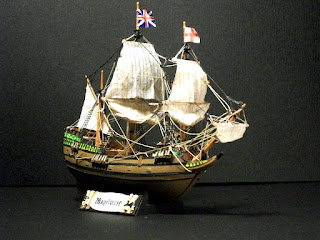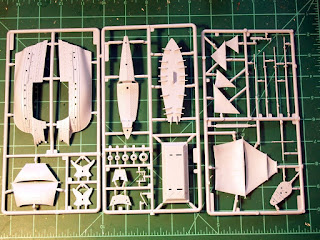As my interest in model sailing ships tends to run towards the smaller end of the spectrum, it should be of no surprise that the products that Pyro created are something I fancy. I do not consider myself an expert on the company, the Pyro Plastics Company of Union, New Jersey, but I've had enough of their products to know what I like.
But briefly, it is important to understand the fate of the Pyro dies. After Pyro, they were passed on to the LifeLike of Baltimore, which produced them until 1979, at which time they ended up in the possession of the Lindberg Models Company. As the product changed hands, the line got smaller and smaller. Currently, Round2 has possession of Lindberg's assets, and therefore it may be assumed that the Pyro dies are there as well. So far, a few of the former Pyro products have been turned out under the Lindberg moniker, most of which had been produced by that latter company a short time ago.
My experience with Pyro models has taught me the following.
Initially, Pyro made very toy like models. They produced a series of warships in the 1950's and early 1960's, all to a box scale and measuring 16" (400mm) in length. These models, while generally accurate in outline, were very crude, markedly toy like. Their first sailing ships were in fact worse. To my knowledge, Pyro initially produced a small number of sailing ships that were nothing more than bathtub toys. They were horribly out of proportion, remarkably crude.
Early in the 1960's, Pyro began producing a series of larger scale ship kits, some which were almost exact plastic knockoffs of wooden kits. These were a quantum improvement over those earlier models, but actually fall outside of the models I really wish to discuss here. However, it was a start.
By the mid-1960's, Pyro turned their attention to producing better models. They introduced a series of 1/1200 waterline World War II warships, that while mixed were welcomed. Around the same time, they began producing sailing ship kits, better ones, at least in complexity and some details. A good number of these appear to have been inspired by Björn Landström's work, though their were certainly other sources of inspiration. Dozens of model ships were produced, with huge differences in accuracy.
Why that was the case is a mystery. A good many of the models were, by the standards of the day, pretty good. Others, though, were either complete fictions in appearance, or simply fell back to those old bathtub toys appearance.
There are two models in the smaller line that I consider to be the best sailing ships that Pyro would produce, a
"Bomb Ketch" (reviewed here) and the Elizabethan warship "
Revenge". Remember, these kits have to be taken in context; comparing them to products from Revell, Airfix, and even Lindberg at the time is a bit unfair. The bomb ketch, for instance, scales out close to 1/150 and while having over sized features like planking, can build up into a rather lovely model with a little work.
The Revenge is in a smaller scale, around 1/260, and like the bomb ketch has over sized planking. However, it captures the appearance of a race-built Elizabethan warship perfectly.
Then there is the whaler "Charles W. Morgan". This model is close to 1/200 scale, and is fairly accurate, if one considers that the ship had been improperly restored, and it is that the kit is based upon; it is full rigged, whereas the ship was originally, operationally, a barque. Some minor hull issues and those "gunports", but it can build up very nicely right out of the box.
Unfortunately, it starts to go downhill from there.
The next best ship from the smaller line is the "Venetian Carrack". This looks to be lifted from Landström in most details. There are a few shape problems around the stern, and the area below to focs'l is questionable, but otherwise is a rather nice model. Scale is close to 1/250. This is followed by their somewhat deceptive "Mayflower". The reason I say deceptive is that the box art depicts a version that very closely resembles the 1957 William A. Baker replica, but the model is a copy of the R.C. Anderson version from the 1920's. It's not a bad model, but there are some details that are perhaps oversimplified, and a stern that is flat a little too far down below the waterline. Scale is about 1/280.
The "Bounty" scales out to 1/180. While the deck captures most of the deck details fairly accurately, the hull is a bit cruder. The headrails are molded into the hull halves, and the area below the waterline at the stern is mysteriously angular. Both problems can be corrected, but work is involved.
The "frigate" "Constellation', scaling out at about 1/360, has an interesting set of problems. While in general it is a fair model (hull is too bluff at the bow and the stern), it borrows detail from the almost fraudulent work done on the full sized ship sitting in Baltimore Harbor. It can be corrected back to making this ship into the sailing corvette that it really was, but does take work. In 1/350 is the clipper ship "Cutty Sark". In profile this model does a fair enough job capturing the prototype. In plan and details, however, it falls short (especially compared to the Imai model).
One lovely, and sadly now hard to find model, is the Tutor warship "Henry Grace A'Dieu". Scale is close to 1/360-1/400. Since most of what we know about the prototype is only speculation, they had to rely upon what evidence was available, in this case another Landström illustration. Aside from the lower hull, which even they had to speculate, the model does a rather nice job capturing the appearance. A note; this is the one kit in this line that I have not personally owned, but admittedly do desire in light of the recent acquisition of the Airfix "Mary Rose".
Inexplicably, there is a model of the 18th century Swedish third rate "Göta Lejon". It is fair in some details, but has a lower hull shape at the stern that is iffy at best, and some details, such as stern galleries, that are questionable.
The frigate "Constitution" is rather smaller, around 1/450, and very basic. The attempts at making the hull planking make the hull coarse, the headrails are solid, the deck guns are wrong. Simpler still is the "HMS Victory". Here, the hull and deck planking give the model an almost rough appearance, and like the Constitution the headrails are solid, with the rest of the details correspondingly crude. In this same scale range is a model of the American clipper ship "Flying Cloud". The only thing it really captures is the hull shape, all other details being over-simplified.
Then the models take a turn for the simpler, and detailing starts to vary.
The "Spanish Galleon" again appears to have been lifted directly from Landström, but the hull at the stern below the waterline is too flat and too deep a transom. Scale is around 1/280. A "Niña" and "Pinta", both in around 1/192, have profiles that appear to have been based on E.A. d'Albertis' work from 1892, but have deck plans that are too sharp at the bow, exaggerated in aft sheer, and transoms too far below their waterlines. There is a model of the "Santa Maria" that, in addition to being in a smaller scale (closer to 1/240), is based on the 1892 Duro-Spanish Commission version. The sheer is too low at the focs'l, too high at the sterncastle, the vertical guards are too vertical instead of following their rake on the plans. The lower hull is a mess, especially at the stern below the waterline. It is also armed with six cannon.
From here, things get significantly cruder.
The "Ark Royal"; what can I say about this model? From what I remember once reading, it was actually based upon a wooden kit that had been produced. If so, it is complete fantasy. From the shape of the hull to the anachronistic ship's wheel, it is utter hogwash. Best for parts only or if you need the lower hull.
The following kits cannot be recommended as models at all. They all suffer from a variety of shape problems, with all but the first one having hull shapes reminiscent of those early bathtub toys that Pyro initially sold as sailing ships; "Barbary Pirate, Brig of War, Bon Homme Richard, Half Moon, and Golden Hind".
As for the larger sailing ships that Pyro tooled, again they run from mediocre to bad. The best of that batch has to be, hands down, the "Sovereign of the Seas". This is, to my knowledge, the only plastic kit version of the ship to have the flat stern found on the Samuel Pepys' painting with Peter Pett with the ship posed to the left, looking directly at the stern. In profile, though, the model is too tall, lacking the sheer as well. It might be possible to correct these, but it will involve work. Still, it can build up nicely. It is adequately detailed, and has Pyro's requisite over sized planking. Scale is close to about 1/225.
Next is the Portuguese armed carrack "Santa Catarina do Monte Sinai". Scale here is close to 1/200, and again appears to have been lifted from the pages of Landström's book "The Ship". It has a hull shape that looks good, but the model, like the preceding, appears too tall. It is possible, with some work, to reduce those castles. It is worth it in my opinion, as this is a model of a rare, and important, type.
The next model is the Dutch man o' war "Gouda". While purporting to be a model of a Dutch third rate, the model has a hull that more resembles that of an armed merchantman, with half the requisite guns. It has plenty of details otherwise, and in this writer's opinion could serve as a basis for a conversion into an early 17th century Spanish galleon in approximately 1/144 scale.
We end this list with the "Saint Louis". This model is very detailed, with plenty of parts. It also has a hull that is almost 40% too short in proportion. As a consequence, it is very round in appearance with an overly long beakhead. Scale is therefore difficult to determine.
Pyro offered us some models of vessels that no other company considered, and produced some models that can build up with work. Unfortunately, they were inconsistent. Still, the models that were better provide us with subjects that are frequently overlooked. Even the models that require work can build up nicely, provided that one approaches them with the understanding that there will be work ahead.
(Addendum & Correction - I am moving the "Brig of War" into a different category. After examining the model, I've discovered that it appears to be based upon the brig "Fair American". There are some changes that are needed, the yards too small, and the proportions are still a little off, but there is model here with some potential. - RRL )



















































